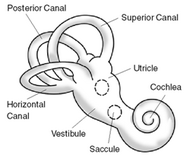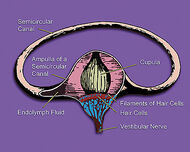No edit summary |
m (Semicircular canal moved to Semicircular canals over redirect: plural) |
Revision as of 09:18, 27 December 2008
Assessment |
Biopsychology |
Comparative |
Cognitive |
Developmental |
Language |
Individual differences |
Personality |
Philosophy |
Social |
Methods |
Statistics |
Clinical |
Educational |
Industrial |
Professional items |
World psychology |
Biological: Behavioural genetics · Evolutionary psychology · Neuroanatomy · Neurochemistry · Neuroendocrinology · Neuroscience · Psychoneuroimmunology · Physiological Psychology · Psychopharmacology (Index, Outline)
| Semicircular canals | ||
|---|---|---|
| Exterior of labyrinth. | ||
| Latin | canalis semicircularis | |
| Gray's | subject #232 1049 | |
| System | ||
| MeSH | A09.246.631.663 | |
| Inner ear illustration showing semicircular canal, hair cells, ampulla, cupula, vestibular nerve, & fluid | ||
The semicircular canals are three half-circular, interconnected tubes located inside each ear that are the equivalent of three gyroscopes located in three planes perpendicular. The vertical canals are positioned at an angle of about 100 degrees relative to one another, while the horizontal canal makes an angle of about 95 degrees with the posterior canal and an angle of about 110 degrees with the anterior canal. Deviations up to 10-15 degrees between individuals are normal. Because the angles between the canals are not perpendicular, movements of the head stimulate horizontal and vertical canals simultaneously.
The three canals are:
Each canal is filled with a fluid called endolymph and contains a motion sensor with little hairs (cilia) whose ends are embedded in a gelatinous structure called the cupula.
The Semicircular canals are a component of the Labyrinth.
See also
References & Bibliography
Key texts
Books
Papers
Additional material
Books
Papers
External links
- nl:Half-cirkelvormige kanalen
| This page uses Creative Commons Licensed content from Wikipedia (view authors). |

